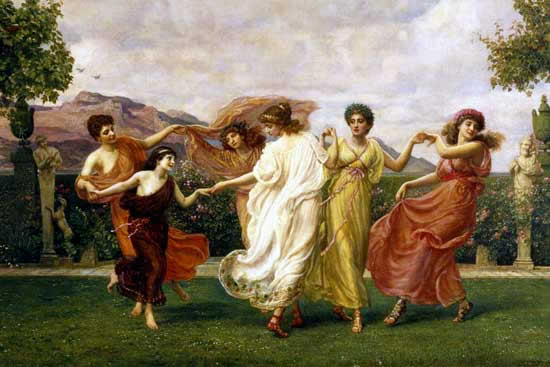Horae

The Horai, latinized Horae ( literally translated as “the hours”) were three goddesses controlling orderly life. They were daughters of Zeus and Themis, half-sisters to the Moirae. There were two generations of Horae: (note: this does not refer to generation in the traditional sense of the second group being offspring of the first; earlier writers recognized the first generation and later authors subscribed to the second.)
First Generation
The first generation consisted of Thallo, Auxo, and Carpo, who were the goddesses of the seasons (the Greeks only recognized spring, summer and autumn). In art, the first generation were usually portrayed as young, attractive women surrounded by colourful flowers and abundant vegetation or other symbols of fertility. They were worshipped primarily amongst rural farmers throughout Greece.
Thallo (literally translated as the one who brings blossoms) (or Thalatte) was the goddess of spring, buds and blooms, the bringer of flowers, and became a protector of youth.
Auxo (pronounced Afxo) or Auxesia is Greek for increaser (as in “plant growth“), and she was worshipped alongside Hegemone in Athens as one of their two Charites.
Carpo, Carpho or Xarpo (translated as the one who brings food – though Robert Graves in his book The Greek Myths translates this name as “withering”) was in charge of autumn, ripening, and harvesting, as well as guarding the way to Mount Olympus and letting back the clouds surrounding the mountain if one of the gods left. She was an attendant to Persephone, Aphrodite and Hera, and was also associated with Dionysus, Apollo and Pan.
Second Generation
The second generation comprised Eunomia, Dike, and Eirene, who were law and order goddesses that maintained the stability of society. They were worshipped primarily in the cities of Athens, Argos and Olympia.
Dike (Greek for justice) was the goddess of moral justice. She ruled over human justice; her mother (Themis) ruled over divine justice. Dike was born a mortal and Zeus placed her on earth to keep mankind just. He quickly learned this was impossible and placed her next to him on Olympus.
Eunomia (Greek for good order – governance according to good laws) was the goddess of law and legislation. The same or a different goddess may have been a daughter of Hermes and Aphrodite.
Eirene, or Irene (Greek for peace); the Roman equivalent was Pax), was the personification of peace and wealth, and was depicted in art as a beautiful young woman carrying a cornucopia, scepter and a torch or rhyton.
Third Generation
Some authors recognise yet a third set of Horae. They were Pherusa (or Pherousa, goddess of substance and farm estates), Euporie (or Euporia, goddess of abundance), and Orthosie (goddess of prosperity).
Fourth Generation
Nonnus in his Dionysiaca mentions a set of four Horae: Eiar, Theros, Cheimon, and Phthinoporon. (The Greek words for Spring, Summer, Autumn and Winter accordingly).
The Hours
Finally, a quite separate suite of Horae presonified the twelve hours (originally only ten), as tutelary goddesses of the times of day. The hours run from just before sunrise to just after sunset, thus winter hours are short, summer hours are long:
* Auge, first light
* Anatole or Anatolia, sunrise
* Mousika or Musica, the morning hour of music and study
* Gymnastika, Gymnastica or Gymnasia, the morning hour of gymnastics/exercise
* Nymphe, the morning hour of ablutions (bathing, washing)
* Mesembria, noon
* Sponde, libations poured after lunch
* Elete, prayer, the first of the afternoon work hours
* Akte, Acte or Cypris, eating and pleasure, the second of the afternoon work hours
* Hesperis, evening
* Dysis, sunset
* Arktos, night sky, constellation

 Buy me a coffee
Buy me a coffee